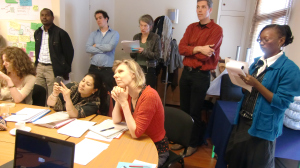Comments on Day 3 of the RMA workshop
Published on: 08/04/2011
Third and final day of the Reflexive Monitoring in Action workshop for sector learning with resource centre networks (repeat it three times in a row to test your alertness and elocution...). We have battled with the onion and we have found time was a tool. Now what? On this final morning we are finalising our work and aligning our reflexive monitoring plans with activities planned. Monitoring is never as useful as when it is integrated (and simple, flexible etc.,) and we have really injected an additional dose of reflection to our planned monitoring and documentation activities. The graft seems to be working out seamlessly in our plans – but of course it is too early to judge how it works in practice.

And practice should be the entire focus of monitoring, whether reflexive or not. Monitoring without improved practice is a waste of resources and efforts. What we have to start with is a simple and compelling reporting template that naturally bridges the documentation of stories and the reports that we prepare. In other words, ahead of us, we have a lot of monitoring, reflections and actions! Here are my take-homes about the priorities to turn reflexive monitoring into actions and improved practices: We first need to reflect upon a framework that binds our stories of change. We can work with the framework that the consultants proposed (see picture on this post): on one axis, the scale of changes (from personal to organisational, network and sector level); on the other axis, the type/intensity of change from a certain awareness (insights), the language used, the actions undertaken and behaviour changes, institutional changes and ultimately results we achieve for the society we are part of. But the boxes would not help, so this would act as more of a continuum where we could chart out our stories. That continuum would also reveal the stage at which we are in the development of resource centre networks and why we focus on e.g. lower scales and on lower intensity changes, but perhaps also why we need to combine activities geared at institutional change and activities targeting for instance the language used by specific individuals? How do we achieve systemic change by working on various levels and various types of change?
Turning our interests into learning questions: a natural follower to the previous point. We have to sharpen and agree on the questions that we want to collectively explore, so we can share our observations from a more common assessment basis.
On a more practical note, how can we keep working well as a pair (resource centre network coordinators and IRC counterparts?), as a group of practitioners working on sector learning, using for instance our six-weekly Skype chats but also feeling free to knock on each other’s door? And how can we work better as resource centre networks - e.g. bringing back the lessons from this workshop and brainstorming some of these ideas with other in-country partners? Finally, in April 2012, we will have another similar event. With the rich learning agenda we have now, soon enough will come the time to start preparing that workshop, at least setting things in motion. After all, reflecting and monitoring is quite some work, but nobody said improving our work would be easy peasy. That said, all of us RMA workshop participants can look back at this great workshop with a happy face and a light heart: we are now getting back to what we do best: action!!!
(By Ewen) P.S: All results, documents, pictures, tweets and presentations will be made available in the coming two weeks and will be mentioned on this blog, so keep watching this space!
At IRC we have strong opinions and we value honest and frank discussion, so you won't be surprised to hear that not all the opinions on this site represent our official policy.